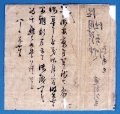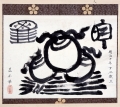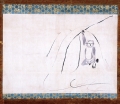( Writings ) 31 found.
| Title | |
|---|---|
 |
Nagaike Mura Muragoin |
| Toshitsune Maeda, 3rd lord of the Kaga Domain, implemented large reforms in agricultural administration. Prior to these reforms, crop yield (kokudaka) was confirmed by official land survey (kenchi) and tax (men) was levied. However, along with the... | |
 |
Nagaike Mura Muragoin |
| This is the Nagaike Mura Muragoin (the Nagaike Village Land Tax Notification) issued in 1670, which describes the details of taxation. It lists 130 koku (kusadaka: total rice production), and a 45% men, or tax rate. | |
 |
Sennyo Shonin Shosoku |
| Sennyo was the 13th chief priest at Higashi Honganji Temple at the beginning of the 17th century. He worked to develop the temple. This document details important points for Buddhist ceremonies for women in Ishikawa County. The Mimo Clan was in c... | |
 |
Kenson Shonin Shosoku |
| The priest Kenson was the second son of Kennyo, the 11th chief priest of Honganji temple. He fought against Nobunaga Oda during the Ishiyama Honganji War between 1570 and 1580. This document is also called "Toraneko no Bunsho" (document... | |
 |
Nonoichi Mura Muragoin |
| This is the Nonoichi Mura Muragoin (the Nonoichi Village Land Tax Notification) issued in 1670, which lists the details of taxation. It lists 3,334 koku (kusadaka: total rice production), and a 53% men, or tax rate. There was also a tax for dyed p... | |
 |
A Letter from Toshinaga Maeda |
| Toshinaga Maeda was born in 1562, the first son of Toshiie Maeda. After the Battle of Sekigahara in 1600, Toshinaga established Kaga Domain, which covered an extremely large area through the integration of Kaga, Ecchu, and Noto Provinces. This let... | |
 |
A Letter from Toshitsune Maeda |
| Toshitsune Maeda was the fourth son of Toshiie Maeda, founder of Kaga Domain. When the feudal lord Toshinaga Maeda retired in 1605, Toshitsune succeeded him. Toshitsune made a major contribution to flood control and agriculture. He also encourage... | |
 |
Shukuokuri Ninsoku Temma no Sho |
| This is an order issued by Kaga Domain to each post town in the domain territory, including Nonoichi, in 1615. It announced the requirement for official permission to engage horses and handlers, and included the admonition that violators would be ... | |
 |
Futsukaichi Mura Muragoin |
| This is the Futsukaichi Mura Muragoin (the Futsukaichi Village Land Tax Notification) issued in 1670. It lists the details of taxation. It lists 548 koku (kusadaka: total rice production), and a 45% men, or tax rate. The interest rate on the rice ... | |
 |
Tokumoto Mura Kimoiri Shihei Gansho (Request by Shihei, Tokumoto Village Organizer) |
| In 1871, because Hakusan Shrine in Tokumoto Village lacked a sacred object, Tokumoto resident Shihei asked Nariyasu Maeda, the 12th lord of Kaga Domain, for something he had written or touched as a sacred object for their shrine. This is the lette... | |
 |
Kanaya Goten Goyokata Akai Kinai Yamazaki Kafukuo Oboe |
| Jikichi Kenbe of Tokumoto Village received these documents at Kanaya Palace in August of 1871. The memorandum describes the decision to give the sacred object from Hachiman Shrine at Kanaya Palace to Tokumoto Village and other matters. | |
 |
Moto-tomura-yaku Seo Magozo Tedai Kenbe Jikichi Ukesho |
| Jikichi Kenbe of Tokumoto Village received these documents at Kanaya Palace in August of 1871. The memorandum describes the decision to give the sacred object from Hachiman Shrine at Kanaya Palace to Tokumoto Village and other matters. | |
 |
Kenbe Jikichi Tsuchijo |
| Jikichi Kenbe of Tokumoto Village received these documents at Kanaya Palace in August of 1871. The memorandum describes the decision to give the sacred object from Hachiman Shrine at Kanaya Palace to Tokumoto Village and other matters. | |
 |
Risei Todori Seo Magozo Gansho |
| The Notification issued by District Official Magozo Seo records Tokumoto Village's donation of money for feudal lord Nariyasu Maeda's move to Tokyo in September 1871. Other remaining documents include letters from Magozo Seo and Jikichi Kenbe. | |
 |
Seo Magozo Shojo |
| The Notification issued by District Official Magozo Seo records Tokumoto Village's donation of money for feudal lord Nariyasu Maeda's move to Tokyo in September 1871. Other remaining documents include letters from Magozo Seo and Jikichi Kenbe. | |
 |
Moto-gojukyoyo Bengata Shojo |
| The Notification issued by District Official Magozo Seo records Tokumoto Village's donation of money for feudal lord Nariyasu Maeda's move to Tokyo in September 1871. Other remaining documents include letters from Magozo Seo and Jikichi Kenbe. | |
 |
Kenbe Jikichi Shojo(1) |
| The Notification issued by District Official Magozo Seo records Tokumoto Village's donation of money for feudal lord Nariyasu Maeda's move to Tokyo in September 1871. Other remaining documents include letters from Magozo Seo and Jikichi Kenbe. | |
 |
Kenbe Jikichi Shojo(2) |
| The Notification issued by District Official Magozo Seo records Tokumoto Village's donation of money for feudal lord Nariyasu Maeda's move to Tokyo in September 1871. Other remaining documents include letters from Magozo Seo and Jikichi Kenbe. | |
 |
Uji Jinja Jinja Go Negai |
| A Request to Rename the Shrine was submitted in October 1874. The Letter from Hajime Tada was written to residents of the village informing them that the feudal lord Nariyasu Maeda was very pleased that they had donated 2 yen to him in return for ... | |
 |
Maedake Kafudai Tada Hajime Shojo |
| A Request to Rename the Shrine was submitted in October 1874. The Letter from Hajime Tada was written to residents of the village informing them that the feudal lord Nariyasu Maeda was very pleased that they had donated 2 yen to him in return for ... | |
 |
Hachiman Okami no Shingogaku |
| The framed name of the Hachiman God was displayed at Hachiman Shrine at Kanaya Palace. On the back of the frame, there is the engraved description of being written by Nariyasu Maeda in 1870. On the box in which this frame was stored, it is written... | |
 |
Hachiman Okami no Shingojiku |
| The framed name of the Hachiman God was displayed at Hachiman Shrine at Kanaya Palace. On the back of the frame, there is the engraved description of being written by Nariyasu Maeda in 1870. On the box in which this frame was stored, it is written... | |
 |
Kame no Ji |
| Kame no Ji was drawn by Nariyasu Maeda when he was 5 years old, and Saru no E was drawn by him when he was 7 years old. Takara no Tama no Zu was drawn by him in 1877. The back of the top of the box shows that this was housed at Kosho Hachiman Shri... | |
 |
Takara no Tama no Zu |
| Kame no Ji was drawn by Nariyasu Maeda when he was 5 years old, and Saru no E was drawn by him when he was 7 years old. Takara no Tama no Zu was drawn by him in 1877. The back of the top of the box shows that this was housed at Kosho Hachiman Shri... | |
 |
Saru no E |
| Kame no Ji was drawn by Nariyasu Maeda when he was 5 years old, and Saru no E was drawn by him when he was 7 years old. Takara no Tama no Zu was drawn by him in 1877. The back of the top of the box shows that this was housed at Kosho Hachiman Shri... | |
 |
Ogimen |
| Kame no Ji was drawn by Nariyasu Maeda when he was 5 years old, and Saru no E was drawn by him when he was 7 years old. Takara no Tama no Zu was drawn by him in 1877. The back of the top of the box shows that this was housed at Kosho Hachiman Shri... | |
 |
Yaso Yuka Ono-ono Onozukara Kobashi |
| Kame no Ji was drawn by Nariyasu Maeda when he was 5 years old, and Saru no E was drawn by him when he was 7 years old. Takara no Tama no Zu was drawn by him in 1877. The back of the top of the box shows that this was housed at Kosho Hachiman Shri... | |
 |
Shimobayashi Mura Muragoin |
| This is a Shimobayashi Mura Muragoin (Shimobayashi Village Land Tax Notification) issued in 1670. It lists the details of taxation. It lists 922 koku (kusadaka: total rice production), and a 51% men, or tax rate. | |
 |
Toheida Shimmura Muragoin |
| This is the Toheida Shimmura Muragoin (the New Toheida Village Land Tax Notification) issued in 1670. It lists the details of taxation. It lists 234 koku (kusadaka: total rice production), and a 55% men, or tax rate. The interest rate on the rice ... | |
 |
Suematsu Mura Muragoin |
| This is the Suematsu Mura Muragoin (the Suematsu Village Land Tax Notification) issued in 1670. It lists the details of taxation. It lists 828 koku (kusadaka: total rice production), and a 56% men, or tax rate. The interest rate on the rice that t... | |
 |
Kambayashi Mura Muragoin |
| This is the 1670 Kambayashi Mura Muragoin (Kambayashi Village Land Tax Notification). It lists the details of taxation. It lists 794 koku (kusadaka: total rice production), and a 60% men, or tax rate. The interest rate on the rice that the domain ... |